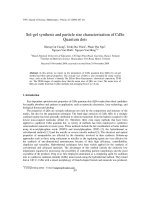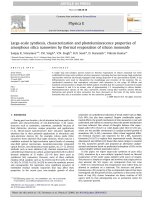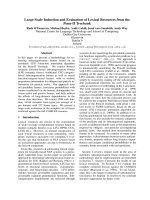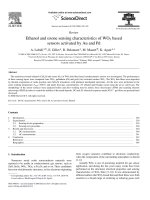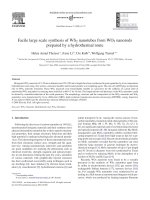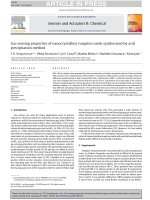- Trang chủ >>
- Khoa Học Tự Nhiên >>
- Vật lý
large - scale synthesis and gas sensing application of vertically
Bạn đang xem bản rút gọn của tài liệu. Xem và tải ngay bản đầy đủ của tài liệu tại đây (1.53 MB, 8 trang )
Sensors and Actuators B 143 (2009) 325–332
Contents lists available at ScienceDirect
Sensors and Actuators B: Chemical
journal homepage: www.elsevier.com/locate/snb
Large-scale synthesis and gas sensing application of vertically aligned and
double-sided tungsten oxide nanorod arrays
Xiaoping Shen
a,b
, Guoxiu Wang
a,∗
, David Wexler
a
a
Institute for Superconducting and Electronics Materials, School of Mechanical, Materials and Mechatronics Engineering,
University of Wollongong, Wollongong, New South Wales 2522, Australia
b
School of Chemistry and Chemical Engineering, Jiangsu University, Zhenjiang 212000, China
article info
Article history:
Received 25 June 2009
Received in revised form 17 August 2009
Accepted 6 September 2009
Available online 17 September 2009
Keywords:
Tungsten oxide
Nanorod arrays
Hydrothermal synthesis
Gas sensing
Sensor
abstract
Large-scale vertically aligned and double-sided Co-doped hexagonal tungsten oxide nanorod arrays have
been successfully synthesized by a facile hydrothermal method without using any template, catalyst,
or substrate. Scanning electron microscopy and transmission electron microscopy analyses reveal an
interesting three-order hierarchical nanostructure from small, single-crystalline nanorods via nanorod
bundles to double-sided nanorod arrays. The optical absorption properties of the Co-doped WO
3
sam-
ples were investigated by ultraviolet–visible spectroscopy, and the results indicate that the Co-doped
WO
3
nanostructures are semiconducting with direct band gaps of 2.26eV and 2.77 eV. The gas sens-
ing performance of the as-prepared Co-doped WO
3
double-sided nanorod arrays was tested towards a
series of typical organic solvents and fuels. The sample shows excellent gas sensing performance towards
1-butanol vapor, with rapid response and high sensitivity. We propose that the double-sided nanorod
arrays are formed from urchin-like microspheres via a self-assembly and fusion process. This new syn-
thesis strategy could be extended to prepare other well-aligned nanorod arrays for many functional
applications.
© 2009 Elsevier B.V. All rights reserved.
1. Introduction
Enormous efforts have been devoted to the development of syn-
thetic strategies for highly organized hierarchical nanostructures
consisting of nanoscale building blocks [1–4], because assembling
the synthesized nanoscale building blocks into advanced struc-
tures is a necessary approach for applications in integrated devices.
Highly ordered arrays of nanorods or nanowires in particular have
aroused continuous interest due to their diverse properties and
potential applications in data storage, catalysis, sensing, field elec-
tron emission, and optoelectronic devices [5–8]. Two versatile
strategies basedon templates and patterned catalysts, respectively,
have been developed to produce nanorods in the form of large-
area arrays [9–11]. However, although the template-based method
can provide good control over the uniformity and dimensions
of nanorods, removal of the template through a post-synthesis
process may cause damage to the nanorod arrays. In addition,
most nanorods synthesized using the template-based method are
polycrystalline instructure, whichmay limit their use in device fab-
rication and fundamental studies. The method involving the use of
a patterned catalyst is able to generate nanorods with controllable
∗
Corresponding author. Fax: +61 2 42215731.
E-mail address: (G. Wang).
sizes and highly crystalline structures. However, the catalyst may
cause contamination of the resultant nanorod arrays,which is often
a great disadvantage to their application. As a template-free and
catalyst-free method, epitaxial growth of free-standing nanorod
arrays has recently been attained, in which a substrate with an
excellent lattice match to the overlying materials is vital to guide
the assembly of one-dimensional (1D) nanoarrays [12,13].Asa
result, this method has largely been limited to particular materials,
notably zinc oxide. Therefore, the development of novel and more
effective strategies for preparing highly ordered nanorod arrays is
of great significance for their practical applications in nanotechnol-
ogy.
Tungsten oxide (WO
3
), as an important n-type semiconductor,
has received wide attention owing to its promising application in
gas sensors, heterogeneous catalysts, chromogenic devices, solar-
energy devices, and field electron emission [14–16]. The syntheses
of various WO
3
nanostructures have been reported, including
nanorods, nanowires, nanotubes, nanobelts, urchin-like super-
structures, and nanostructured thin films [17–19]. Moreover, it
has been found that metal-doped tungsten oxide may exhibit
improved optical and electrical properties. For example, Na-doped
tungsten oxide has proved to be a high temperature supercon-
ductor [20], and Cr-doped WO
3
nanocrystals showed excellent
gas sensing performance towards acetone [21]. Herein, we report
a novel strategy for preparing large-area Co-doped WO
3
double-
0925-4005/$ – see front matter © 2009 Elsevier B.V. All rights reserved.
doi:10.1016/j.snb.2009.09.015
326 X. Shen et al. / Sensors and Actuators B 143 (2009) 325–332
sided nanorod arrays without using any template, catalyst, or
substrate. The resulting products were characterized by X-ray
diffraction (XRD), X-ray photoelectron spectroscopy (XPS), field
emission scanning electron microscopy (FE-SEM), high-resolution
transmission electron microscopy (HRTEM), selected area electron
diffraction (SAED), Raman spectroscopy, and ultraviolet–visible
(UV–vis) spectroscopy. A mechanism is proposed to explain the
growth of the double-sided nanorod arrays. Moreover, the gas
sensing performance of the as-synthesised Co-doped WO
3
nanos-
tructures was investigated towards a series of flammable and toxic
organic solvents. We found that the as-synthesised Co-doped WO
3
nanorod arrays have a fast, highly sensitive, and fairly selective
response to 1-butanol gas.
2. Experimental details
All chemicals are ACS reagent and were used directly as
purchased from Sigma–Aldrich. In a typical experiment for synthe-
sizing Co-doped hexagonal tungsten oxide double-sided nanorod
arrays, 0.815 g of Na
2
WO
4
·2H
2
O was dissolved in 10mL of distilled
water. The solution was acidified to a pH range of 1–1.2 using HCl
solution (3mol L
−1
). Then, 0.63 g of H
2
C
2
O
4
was added to the mix-
ture and the mixture was diluted to 25 mL. After that, a stable
WO
3
sol was formed. 16 mL of the WO
3
sol was transferred into
a 20 mL Teflon-lined autoclave, and then 0.80 g Na
2
SO
4
and 5.0mg
Co(NO
3
)
2
·6H
2
O were added to the solution. The autoclave was
sealed and maintained at 180
◦
C for 10 h. After the autoclave was
naturally cooled to room temperature, the resulting solid products
were separated by centrifugation, washed three times with dis-
tilled water and ethanol, respectively, and dried at 60
◦
C overnight.
To further improve the crystallinity and phase purity, the products
were annealed at 400
◦
C for 4h.
The as-prepared samples were characterized by X-ray diffrac-
tion (XRD, Cu K␣ radiation, Philips 1730), scanning electron
microscopy (SEM, JSM-6460 and JSM-6700F), transmission elec-
tron microscopy (TEM), and high-resolution TEM (HRTEM, JEOL
2011). Samples for TEM were prepared by dropping the products
on a carbon-coated copper grid after strong ultrasonic dispersion
in absolute ethanol. X-ray photoelectron spectroscopy (XPS) mea-
surements were carried out with an ESCALab220i-XL spectrometer
by using a twin-anode Al K␣ (1486.6 eV) X-ray source. All the
spectra were calibrated according to the binding energy of the
adventitious C1s peak at 284.8eV. The band gap of the Co-doped
WO
3
was determined by UV–vis spectroscopy (Shimadzu 1700).
Raman spectroscopy (HR 800) was performedat room temperature
with an excitation wavelength of 632.8 nm.
The gas sensing properties were measured using a WS-30A gas
sensor measurement system. The gas sensor was fabricated as fol-
lows: the Co-doped WO
3
sample was mixed with polyvinyl acetate
(PVA) binder (1 wt.%) to form a slurry, and then pasted onto a
ceramic tube (2 mm in diameter) by a doctor blade to form a thin
film between two Au electrodes,which had been previously printed
on the ceramic tube and were connected with four platinum wires.
As a comparison, gas sensing properties of commercial WO
3
pow-
der (Fluka) were also measured. The commercial WO
3
powder is a
well crystallinepowder witha crystalsize inthe rangeof afew hun-
dreds nanometers. Fig. S-1 shows the FE-SEM image of commercial
WO
3
powders (Supplementary data). Given amounts of test gases
were injected into the testing chamber by a microsyringe. Gas sens-
ing measurements were carried out at a working temperature of
200
◦
C with 30–40% relative humidity. Fig. S-2 shows a schematic
diagram of the sensor system (Supplementary data). The gas sensor
was fabricated according to the method described in Section 2. The
working temperature of the sensor can be controlled by adjusting
the heating voltage (V
heating
) across a resistor inside the ceramic
tube. A reference resistor is put in series with the sensor to form
a complete measurement circuit. In the test process, a working
voltage (V
working
) was applied. By monitoring the voltage (V
output
)
across the reference resistor, the response of the sensor in air or in
a test gas could be measured. The gas sensing response is defined
as the ratio of the stationary electrical resistance of the sensor in
air (R
air
) to the resistance in the test gas (R
gas
), i.e., R = R
air
/R
gas
.
3. Results and discussion
The phase of the obtained products was determined by XRD.
As shown in Fig. 1, all the diffraction peaks of the annealed product
can be readilyindexed to hexagonalstructure WO
3
with lattice con-
stants a = 7.3223 Å and c =7.6574 Å, which are slightly smaller than
the standard values for bulk hexagonal WO
3
(JCPDS No. 85-2460,
a =7.3242 Å and c = 7.6624Å). Before annealing, the sample showed
several impurity peaks, suggesting that the annealing is necessary
to obtain pure phase WO
3
. In addition, the relative strength of the
(0 02) peak was significantly increased by the annealing treatment,
suggesting that annealing also improves the crystallinity of the
product. It is well known that hexagonal (h) WO
3
is a metastable
phase and can transform into monoclinic (m) WO
3
at high tem-
perature. Recently, Szilágyi et al. pointed out that the structure
of hexagonal WO
3
cannot be maintained without some stabilizing
ions or molecules in the hexagonal channels, and thus the exis-
tence ofstrictly stoichiometric hexagonal WO
3
is questionable[22].
X-ray photoelectron spectroscopy (XPS) (Fig. 2) was employed to
determine the chemical composition and oxidation states of the
elements in the present sample. It was revealed that the product
contains the elements tungsten, oxygen, sodium and cobalt with
a W:O:Na:Co molar ratio of about 1:2.92:0.40:0.02. The presence
of such a high Na
+
content of the product strongly supports Szilá-
gyi’s viewpoint. This may explain why alkaline (Na
+
,K
+
,Cs
+
, etc.)
or NH
4
+
ions were needed to prepare h-WO
3
. Alkaline (Na
+
,K
+
,Cs
+
,
etc.) or NH
4
+
ions can stabilize the hexagonal structure in such a
way that they are located in the hexagonal channels of crystallites
and block the thermodynamically favored hexagonal–monoclinic
transformation.
As shown in Fig. 2, the O1s peak is located at 530.7 eV, which
is ascribed to the W–O peak. The W4f peaks located at 36.4eV and
38.4 eV can be attributed to W4f
7/2
and W4f
5/2
, respectively, which
are in good agreement with the reported values [23]. These two
peaks are well separated without any shoulder, which indicates
that almost all W atoms are in the +6 oxidization state [24]. The
Fig. 1. X-ray diffraction patterns of Co-doped WO
3
nanorod arrays: (a) before
annealing and (b) after annealing.
X. Shen et al. / Sensors and Actuators B 143 (2009) 325–332 327
Fig. 2. XPS spectra of Co-doped WO
3
nanorod arrays.
Na1s peak at 1070.9 eV is consistent with the +1 oxidation state
of sodium [25]. A Co2p signal located at 780.3 eV was detected,
showing that Co exists in the +2 oxidation state in the product [26].
However, the Co2p signal is weak due to the low Co content in
the product. Therefore, the above results confirmed the successful
preparation of the Co-doped hexagonal tungsten oxide.
Fig. 3 shows FE-SEM images of the Co-doped WO
3
sample.
Fig. 3(a) is a general view of a double-sided nanorod array. It
can be seen that the double-sided nanorod array has a uniform
thickness of about 10 m, with the nanorods growing from the
center in two opposite directions. Fig. 3(b) and (c) are top views
of the nanorod array at different magnifications. It can be seen
that the nanorods, with a diameter of about 200 nm, are densely
arranged in a well ordered way to form a large-area ordered array.
It was found that the area of a single ordered array can reach
1.0 × 10
4
m
2
. Furthermore, the high-magnification FE-SEM image
(Fig. 3(d)) reveals that the nanorods are actually composed of
a number of smaller nanorods with a diameter of about 20 nm.
Therefore, they will be referred to as nanorod bundles hereafter.
We also performed FE-SEM observation on a cross-section of the
double-sided nanorod array (as shown in Fig. S-3, supplemen-
tary data). Elemental energy dispersive X-ray (EDX) mapping of
Co was obtained on the same area. We found that the distribu-
tion of the dopant element Co is uniform in the cross-section. The
above results unambiguously demonstrate that a novel Co-doped
WO
3
nanostructure with a three-order hierarchical architecture
from small nanorods via nanorod bundles to double-sided nanorod
arrays has been achieved.
A further investigation of the Co-doped WO
3
nanorod arrays
was conductedby TEM and HRTEM analysis.The low-magnification
TEM image (Fig. 4(a)) shows some straight nanorod bundles with
a diameter of about 200 nm and a length up to about 5 m. A
high-magnification TEM image (Fig. 4(b)) reveals that the nanorod
bundles consist of smaller nanorods with a diameter of about
20 nm. These results are consistent with the FE-SEM observations.
Selected area electron diffraction (SAED) pattern (inset in Fig. 4(b))
taken from this nanorod bundle shows regular diffraction spots,
which can be indexed as hexagonal WO
3
single crystal recorded
along the [1 1 0]zone axis anddemonstrates that theWO
3
nanorods
grow along the [0 01] direction. The SAED pattern also reveals
that the nanorods in the bundles consist of a perfectly oriented
assembly, which is further confirmed by the HRTEM analysis. We
have performed extensive TEM observationson different individual
bundles and found that all of them consist of small nanorods and
grow along [0 01] crystal direction (Fig. S-4, supplementary data).
As shown in Fig. 4(c) and (d), the parallel lattice fringes among
the different primary nanorods and grain boundaries clearly show
the oriented aggregation and high crystallinity of the primary
nanorods. The degree of fusion of the primary nanorods in the
bundles shows a gradual increase from the top to the base of the
bundles. Fig. 4(e) shows a HRTEM image of the middle section of
a primary nanorod, from which the (1 0 0) lattice planes with a d-
spacing of 0.64 nm can be clearly distinguished. It was found that
preferential growth occurred parallel to the (1 00) lattice plane,
which is in consistent with the [0 01] growth direction determined
by SAED. Fig. 4(f) shows a lattice resolved HRTEM image of the tip
of a primary nanorod. Thecorresponding SAED pattern is presented
as the inset in Fig. 4(f), confirmed the single-crystalline nature of
the primary nanorod.
Based on the experimental observations, we propose that the
formation process of the Co-doped WO
3
double-sided nanorod
arrays can be divided into three steps. In the initial stage, the
nanoparticles are quickly grown and spontaneously aggregate into
large spheres to minimize their surface area. In the second step, the
as-formed microspheres serve as substrates for epitaxial growth of
c-axis oriented WO
3
nanorods with the assistance of SO
4
2−
ions.
At the same time, because of their high surface energy, the adja-
cent WO
3
nanorods tend towards oriented attachment and then
328 X. Shen et al. / Sensors and Actuators B 143 (2009) 325–332
Fig. 3. FE-SEM images of Co-doped WO
3
nanorod arrays: (a) a general side view of double-sided nanorod arrays, (b) and (c) top views of the nanorod arrays at different
magnifications, (d) high-magnification FEG-SEM image of the Co-doped WO
3
nanorod arrays, with the inset showing a high-resolution view of a single nanorod bundle.
partly fuse to form bunch-like structures [27–29]. As observed
by TEM analysis, the bunch-like structures become more smooth
and regular from the tip to the base of the bundles. We believe
that Ostwald-ripening works simultaneously with the oriented
attachment to remedy the defects, leading to a smooth and regu-
lar surface of the base parts. Thus, urchin-like architectures with
WO
3
nanorod bundles on the surfaces of the microspheres are
formed. This is supported by the evidence that several hemispher-
ical regions (Fig. 5(a)) and sphere-like cores with nanorod bunches
on their surfaces (Fig. 5(b)) have been found in the Co-doped WO
3
products. This process is similar to what happens in the synthesis
of WO
3
urchin-like microspheres. Finally, the as-formed urchin-
like microspheres further self-assemble and fuse into well-aligned
double-sided nanorod arrays with the help of dopant Co
2+
and an
accompanying Ostwald-ripening process. To the best of our knowl-
edge, thisis the first time that the observation of large-area uniform
double-sided nanorodarrays formedby self-assemblyand fusion of
urchin-like nanostructures has been reported. Scheme 1 shows the
schematics of the formation process of the Co-doped WO
3
double-
sided nanorod arrays, elucidating the growth mechanism of the
nanorod arrays.
Raman scattering is very sensitive to the microstructure of
nanocrystalline materials, so it was employed to determine the
nanostructure of the Co-doped WO
3
nanorod arrays. As shown in
Fig. 6(a), the Raman spectrum of the Co-doped WO
3
nanostruc-
tures shows five obvious Raman peaks located at around 270 cm
−1
,
327 cm
−1
, 713cm
−1
, 808cm
−1
, and 927 cm
−1
. The Raman shifts are
consistent with the fundamental modes of crystalline h-WO
3
. The
bands at 713 cm
−1
and 808cm
−1
can be assigned to the O–W–O
stretching modes, while the bands at 270cm
−1
and 327 cm
−1
cor-
respond to the O–W–O bending modes of the bridging oxygen. The
weak Raman peak at 927 cm
−1
may be attributed to a stretching
mode of the terminal W
O. Although this latter band is charac-
teristic of tungsten oxide hydrates, it can appear in WO
3
via the
adsorption of water molecules [30]. The Raman spectrum provides
clear evidence for the highstructural qualityand phase-pure nature
of Co-doped WO
3
nanorod arrays. Theoptical absorptionproperties
of the as-prepared Co-doped WO
3
nanostructures were investi-
gated at room temperature by UV–visible spectroscopy. As shown
in Fig. 6(b), the spectrum shows one absorption peak at about
281 nm. WO
3
is an n-type semiconductor [31], and its optical band
gap can be estimated using the following formula:
(˛h)
n
= B(h − E
g
) (1)
where ˛ is the absorption coefficient, h is the photon energy, B
is a constant relative to the material, E
g
is the band gap, and n
is either 1/2 for an indirect transition or 2 for a direct transition.
The (˛h)
2
versus h curve for the product is shown in the inset
in Fig. 4(b). The value of h extrapolated to ˛ = 0 gives the absorp-
tion band gap energy. Two regions with a linear relationship are
observed in the ranges of 3.5–4.2eV and 5.0–6.0 eV, respectively,
giving two E
g
values of 2.77 eV and 2.26eV. The band gap of 2.77 eV
can be attributed to the transition between the 2p valence band
formed by oxygen and the 5d conduction band of tungsten, while
the 2.26eV bandgap may be associated with the O
−II
→ Co
II
charge
transfer process (with the Co
II
level located below the conduction
band). However, the band gap of 2.77 eV is much lower than the
reported directband gapsof WO
3
. Theband edgeposition for amor-
phous WO
3
in contact with an aqueous electrolyte at a pH of ∼1is
about 3.2 eV [32]. Two distinct direct interband transition energies
of 3.52eV and 3.74 eV for WO
3
were also observed by Koffyberg
et al. [33]. The lower band gap of the Co-doped WO
3
may reflect
doping effects. It is well known that in doped compound semi-
conductors, in contrast with un-doped ones, the impurity states
play a special role in the electronic energy structures and transi-
tion probabilities. In addition, it is found that the best fit of Eq. (1)
to the absorption spectrum of the product gives n = 2, which sug-
gests that the as-obtained Co-doped WO
3
is semiconducting with
direct transitions at these energies.
Chemical sensors play an important role in the areas of emis-
sions control, environmental protection, public safety, and human
health. Much more public concern over serious environmental
issues is further promoting the development of sensors with both
high sensitivity and rapid response. It has been well documented
that the ultra-high surface-to-volume ratios of nanostructured
materials make their electrical conductivities extremely sensitive
to surface-adsorbed species and make them excellent candidates
for gas sensing applications [34,35]. The gas sensing performance
X. Shen et al. / Sensors and Actuators B 143 (2009) 325–332 329
Fig. 4. TEM and HRTEM images of Co-doped WO
3
nanorod arrays: (a) low TEM images of separated nanorod bundles, (b) high-magnification TEM images showing the
bundle-like nanostructures, (c) and (d) HRTEM images showing the lattice structures of the nanorod bundles, (e) and (f) lattice resolved HRTEM images of the primary
nanorods. The inset in (b) and (f) are the corresponding SAED patterns.
of the Co-doped WO
3
nanorod arrays was investigated for sev-
eral ordinary organic solvents and fuels, including acetone, ethanol,
propanol, butanol,toluene, heptane, acetic acid, and gasoline. Some
of these chemicals are very important industrial raw materials,
and the others are arousing more and more attention because of
the possibility of their use as automotive fuels or gasoline compo-
nents. Therefore, highly sensitive gas sensors are important to the
practical applications of these flammable gases.
The real-time sensing responses towards 1-butanol of sensors
based on the Co-doped WO
3
nanostructures and on commercial
WO
3
powder are displayed in Fig. 7(a). It can be seen that the
sensing response (R
air
/R
gas
) of the sensor increased abruptly on the
injection of 1-butanol, then decreased rapidly, and recovered to
its initial value after the test gas was purged. The magnitude of
the response of the sensor based on the Co-doped WO
3
nanorod
arrays improved dramatically with increasing concentration of the
Fig. 5. (a) FE-SEM image shows a hemispherical region (enclosed by the circle) in a nanorod array. (b) Cross-sectional FE-SEM image showing the sphere-like cores (as
indicated by the circles) in the Co-doped WO
3
double-sides nanorod arrays.
330 X. Shen et al. / Sensors and Actuators B 143 (2009) 325–332
Scheme 1. Schematic diagram of the proposed growth mechanism of the Co-doped WO
3
double-sided nanorod arrays.
test gas and was much higher than that of the commercial pow-
der. This means that the Co-doped WO
3
nanorod arrays are much
more sensitive to 1-butanol than the commercial powder. After
many cycles between the test gas and fresh air, the resistance of
the sensor was still able to recover its initial state, which indi-
cates that the sensor has an excellent reversibility. The response
time and recovery time (defined as the time required to reach 90%
Fig. 6. (a) Raman spectrum of the Co-doped WO
3
double-sided nanorod arrays. (b)
UV–vis spectrum of the Co-doped WO
3
double-sided nanorod arrays. The inset is
(˛h)
2
vs. h curve showing the band gap energies.
of the final equilibrium value) of the sensor were only 1–2 s and
2–4 s, respectively. The response characteristic curves of the sen-
sors towards other gases are similar to that for 1-butanol and are
not shown here. The major charge carriers are electrons for n-type
semiconductors. Upon exposure to a reducing gas, the density of
n-type charge carriers (electrons) would increase due to surface
Fig. 7. (a) Real-time sensing responses towards 1-butanol of the sensor made from
the Co-doped WO
3
double-sided nanorod arrays and commercial WO
3
powders.
(b) Sensing responses vs. gas concentrations of various gases, including 1-butanol,
acetone, toluene, 2-propanol, acetic acid, ethanol, gasoline, and heptane.
X. Shen et al. / Sensors and Actuators B 143 (2009) 325–332 331
adsorption and chemical reaction between the gas and the oxy-
gen adsorbates (electron acceptors), resulting in a decrease in the
sensor resistance.
The sensing responses as a function of vapor concentration from
5 ppm to 1000 ppm are shown in Fig. 7(b). It can be seen that the
responses took on an exponential rate of increase at first (below
200 ppm), which then changed to a linear increase in the range
of 200–1000 ppm. As a whole, the sensing responses decreased
in the sequence of 1-butanol, acetone, toluene, 2-propanol, acetic
acid, ethanol,gasoline, andheptane. TheCo-doped WO
3
nanostruc-
tures exhibited a high sensing response to 1-butanol vapor, and
the R
air
/R
gas
value was 8.5 at the very low concentration of 5 ppm,
but reached 232 at 1000 ppm. The sensing responses to 2-propanol,
ethanol and gasoline are 71, 50, and 37, respectively, at the concen-
tration of 1000 ppm. As shown in Fig. 5(b), the sensing responses
of the Co-doped WO
3
nanorod arrays towards acetone, toluene,
acetic acid, and heptane are 122, 95, 66, and 31, respectively. These
results indicate that the Co-doped WO
3
nanostructure-based sen-
sor is highly sensitive to these organic gases. It should be noted that
the relativelylow operation temperature helps to decrease thecon-
sumption of energy and can improve the suitability of the sensor
in some particular situations. It is well known that WO
3
,asann-
type semiconductor, is a good candidate for detecting the inorganic
gases O
3
,NO
x
, and H
2
S [36], but is less sensitive to hydrocarbons.
Nevertheless, our investigations illustrate that doping, and control
of the morphology and size of the nanorod arrays has endowed
WO
3
with better sensing performance towards hydrocarbon gases
at the relatively low operation temperature of 200
◦
C.
4. Conclusions
In summary,well-aligned Co-doped WO
3
double-sided nanorod
arrays have been synthesized by a facile hydrothermal method
without using any template, catalyst, or substrate. An interest-
ing three-order hierarchical nanostructure, from small nanorods
via nanorod bundles to double-sided nanorod arrays, has been
observed by FE-SEM and TEM. It was discovered that the double-
sided nanorod arrays are formed from urchin-like microspheres
via a self-assembly and fusion process. This may provide a new
strategy for large-scale preparation of well-aligned nanorod arrays,
with the advantages of simplicity, low cost, and no introduced alien
species. The Co-doped WO
3
nanorod arrays are semiconducting,
with direct band gaps of 2.26eV and 2.77 eV, and show good sens-
ing performance towards 1-butanol vapor, with rapid response and
high sensitivity. The results highlight the potential applications
of the Co-doped WO
3
double-sided nanorod arrays in monitoring
flammable and toxic organic gases.
Acknowledgements
This work was financially supported by the Australian Research
Council (ARC) through an ARC Discovery project (DP0559891).
Appendix A. Supplementary data
Supplementary data associated with this article can be found, in
the online version, at doi:10.1016/j.snb.2009.09.015.
References
[1] F.X. Redl, K.S. Cho, C.B. Murray, S. O’Brien, Three-dimensional binary superlat-
tices of magnetic nanocrystals and semiconductor quantum dots, Nature 423
(2003) 968–971.
[2] S. Park, J.H. lim, S.W. Chung, C.A. Mirkin, Self-assembly of mesoscopic
metal–polymer amphiphiles, Science 303 (2004) 348–351.
[3] X.D. Liu, B. Lu, T. Iimori, K. Nakatsuji, F. Komori, Self-assembled MnN super-
structure, Phys. Rev. Lett. 98 (2007) 066103.
[4] X.F. Duan, C.M. Lieber, General synthesis of compound semiconductor
nanowires, Adv. Mater. 12 (2000) 298–302.
[5] J.F. Wang, M.S. Gudiksen, X.F. Duan, Y. Cui, C.M. Lieber, Highly polarized pho-
toluminescence and photodetection from single indium phosphide nanowires,
Science 293 (2001) 1455–1457.
[6] X.Y. Kong, Z.L. Wang, Spontaneous polarization-induced nanohelixes,
nanosprings and nanorings of piezoelectric nanobelts, Nano Lett. 3 (2003)
1625–1631.
[7] X.Y. Kong, Y. Ding, R. Yang, Z.L. Wang, Single-crystal nanorings formed by epi-
taxial self-coiling of polar nanobelts, Science 303 (2004) 1348–1351.
[8] Y.N. Xia, P.D. Yang, Y.G. Sun, Y.Y. Wu, B. Mayers, B. Gates, Y.D. Yin, F. Kim, Y.Q.
Yan, One-dimensional nanostructures: synthesis, characterization, and appli-
cations, Adv. Mater. 15 (2003) 353–389.
[9] C.R. Martin, Membrane-based synthesis of nanomaterials, Chem. Mater. 8
(1996) 1739–1746.
[10] L.M. Dai, A. Patil, X.Y. Gong, Z.X. Guo, L.Q.liu, Y. liu, D.B. Zhu, Aligned nanotubes,
Chemphyschem 4 (2003) 1150–1169.
[11] K.P. Musselman, G.J. Mulholland, A.P. Robinson, L. Schmidt-Mende, J.L.
MacManus-Driscoll, Low-temperature synthesis of large-area, free-standing
nanorod arrays on ITO/glass and other conducting substrates, Adv. Mater. 20
(2008) 4470–4475.
[12] L. Vayssieres, K. Keis, S.E. Lindquist, A. Hagfeldt, Purpose-built anisotropic metal
oxide material: 3D highly oriented microrod array of ZnO, J. Phys. Chem. B 105
(2001) 3350–3352.
[13] L. Vayssieres, L. Rabenberg, A. Manthiram, Aqueous chemical route to ferro-
magnetic 3-d arrays of iron nanorods, Nano Lett. 2 (2002) 1393–1395.
[14] J. Polleux, A. Gurlo, N. Barsan, U. Weimar, M. Antonietti, M. Niederberger,
Template-free synthesis and assembly of single-crystalline tungsten oxide
nanowires and their gas-sensing properties, Angew. Chem. Int. Ed. 45 (2006)
261–265.
[15] A. Ponzoni, E. Comini, G. Sberveglieri, J. Zhou, S.Z. Deng, N.S. Xu, Y. Ding, Z.L.
Wang, Ultrasensitive and highly selective gas sensors using three-dimensional
tungsten oxide nanowire networks, Appl. Phys. Lett. 88 (2006) 20310.
[16] S.H. Baeck, K.S. Choi, T.F. Jaramillo, G.D. Stucky, E.W. McFarland, Enhancement
of photocatalytic andelectrochromicpropertiesofelectrochemicallyfabricated
mesoporous WO
3
thin films, Adv. Mater. 15 (2003) 1269–1273.
[17] Z.G. Zhao, M.Miyauchi,Nanoporous-walled tungsten oxide nanotubesashighly
active visible-light-driven photocatalysts, Angew. Chem. Int. Ed. 47 (2008)
7051–7055.
[18] C. Santato, M. Odziemkowski, M. Ulmann, J. Augustynski, Crystallographically
oriented mesoporous WO
3
films: synthesis, characterization, and applications,
J. Am. Chem. Soc. 123 (2001) 10639–10649.
[19] E. Widenkvist, R.A. Quinlan, B.C. Holloway, H. Grennberg, U. Jansson, Synthe-
sis of nanostructured tungsten oxide thin films, Cryst. Growth Des. 8 (2008)
3750–3753.
[20] A. Shengelaya, S. Reich, Y. Tsabba, K.A. Muller, Electron spin resonance and
magnetic susceptibility suggest superconductivity in Na doped WO
3
samples,
Eur. Phys. J. B 12 (1999) 13–15.
[21] L. Wang, A. Teleki, S.E. Pratsinis, P.I. Gouma, Ferroelectric WO
3
nanoparticles
for acetone selective detection, Chem. Mater. 20 (2008) 4794–4796.
[22] I.M. Szilágyi, J. Madarász, G. Pokol, P. Király, G. Tárkányi, S. Saukko, J. Mizsei,
A.L. Tóth, A. Szabó, Varga-Josepovits, Stability and controlled composition of
hexagonal WO
3
, Chem. Mater. 20 (2008) 4116–4125.
[23] H. Qi, C.Y. Wang, J. Liu, Simple method for the synthesis of highly oriented
potassium-doped tungsten oxide nanowires, Adv. Mater. 15 (2003) 411–414.
[24] Z.J. Gu, H.Q. Li, T.Y. Zhai, W.S.Yang, Y.Y.Xia, Y.Ma,J.N.Yao,Large-scale synthesis
of single-crystal hexagonal tungsten trioxide nanowires and electrochemical
lithium intercalation into the nanocrystals, J. Solid State Chem. 180 (2007)
98–105.
[25] Y. Miura, H. Kusano, T. Nanba, S. Matsumoto, X-ray photoelectron spectroscopy
of sodium borosilicate glasses, J. Non-Cryst. Solids 290 (2001) 1–14.
[26] C. Huang, X. Liu, L. Kong, W. Lan, Q. Su, Y. Wang, The structural and magnetic
properties of Co-doped titanate nanotubes synthesized under hydrothermal
conditions, Appl. Phys. A 87 (2007) 781–786.
[27] R.L. Penn, J.F. Banfield, Imperfect oriented attachment: dislocation generation
in defect-free nanocrystals, Science 281 (1998) 969–971.
[28] J.F. Banfield, S.A. Welch, H. Zhang, T.T. Ebert, R.L. Penn, Aggregation-based
crystal growth and microstructure development in natural iron oxyhydroxide
biomineralization products, Science 289 (2000) 751–754.
[29] C. Pacholski, A. Kornowski, H. Weller, Self-assembly of ZnO: from nanodots, to
nanorods, Angew. Chem. Int. Ed. 41 (2002) 1188–1191.
[30] C.V. Ramana, S. Utsunomiya, R.C. Ewing, C.M. Julien, U. Becker, Structural sta-
bility and phase transitions in WO
3
thin films, J. Phys. Chem. B 110 (2006)
10430–10435.
[31] M. Gratzel, Photoelectrochemical cells, Nature 414 (2001) 338–344.
[32] A. Hagfeldt, M. Graetzel, Light-induced redox reactions in nanocrystalline sys-
tems, Chem. Rev. 95 (1995) 49–68.
[33] F.P. Koffyberg, K. Dwight, A. Wold, Interband transitions of semiconducting
oxides determined from photoelectrolysis spectra, Solid State Commun. 30
(1979) 433–437.
[34] Y. Cui, Q.Q. Wei, K.K. Park, C.M. Lieber, Nanowire nanosensors for highly sen-
sitive and selective detection of biological and chemical species, Science 293
(2001) 1289–1292.
[35] X.L. Gou, G.X. Wang, J. Yang, J.S. Park, D.J. Wexler, Chemical synthesis, charac-
terisation and gas sensing performance of copper oxide nanoribbons, J. Mater.
Chem. 18 (2008) 965–969.
332 X. Shen et al. / Sensors and Actuators B 143 (2009) 325–332
[36] C.S. Rout, M. Hegde, C.N.R. Rao, H
2
S sensors based on tungsten oxide nanos-
tructures, Sens. Actuators B 128 (2008) 488–493.
Biographies
X.P. Shen received his PhD degree in inorganic chemistry in 2005 from Nanjing
University, China. He is a professor at School of Chemistry and Chemical Engineer-
ing, Jiangsu University since 2006. He is currently working as a visiting Professor at
School of Mechanical, Materials and Mechatronic Engineering, University of Wol-
longong, Australia. His major research interests include nanostructured materials
and molecule-based magnetic materials.
G.X. Wang received his PhD degree in Materials Science and Engineering in 2001
from University of Wollongong, Australia. He currently is working as an Associate
Professor at School of Mechanical, Materials and Mechatronic Engineering, Univer-
sity of Wollongong. His major research interests include nanostructured functional
materials, materials chemistry in energy storage and conversion, and development
of chemical and biological sensors.
D. Wexler received his PhD degree in Materials Science and Engineering in 1991
from Monash University, Australia. He currently is working as a senior research
fellow at School of Mechanical, Materials and Mechatronic Engineering, University
of Wollongong. His major research interests include nanomaterials synthesis and
TEM and HRTEM characterization of materials.

